Sony EE34: Sony Makes Budget AMD Laptops?
by Dustin Sklavos on February 22, 2011 4:43 PM ESTAnother Bad 720p Screen
Given the budget nature of the Sony EE34 it's probably not unreasonable to expect a poor quality screen, but the one on this notebook seems uncharacteristically bad. My current whipping boy for bad screens is Gateway's ID49C, and as luck would have it the EE34 exhibits some very similar characteristics to that one. Dithering and latticing seem remarkably just as pronounced, and there even seem to be some minor issues with ghosting. None of these are dealbreakers, but know what you're getting into: unless you're really on a tight budget you're not going to want the EE34's screen to be your primary.
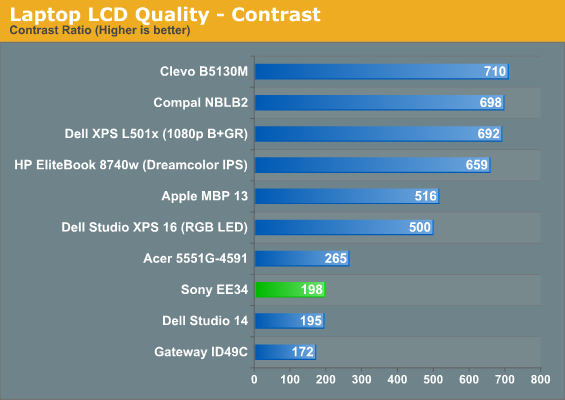
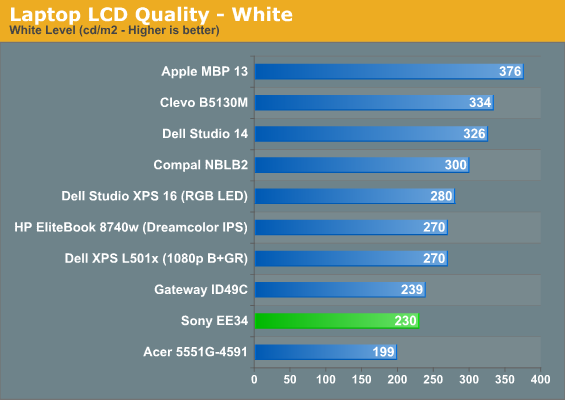
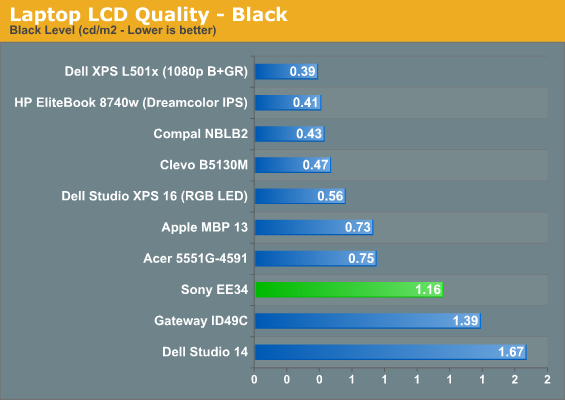
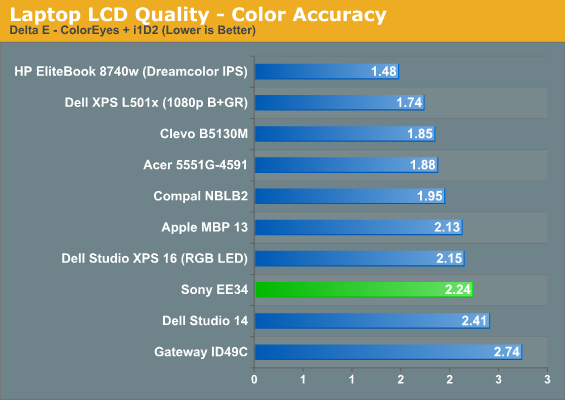
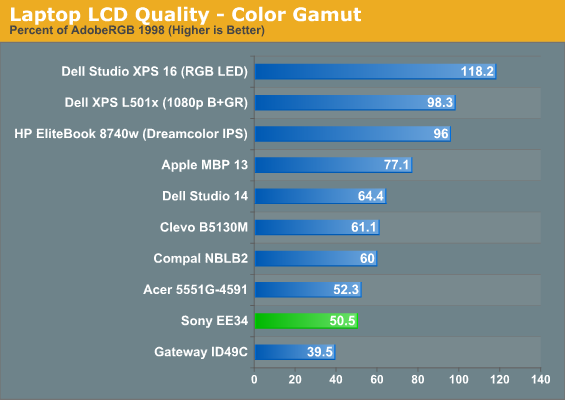
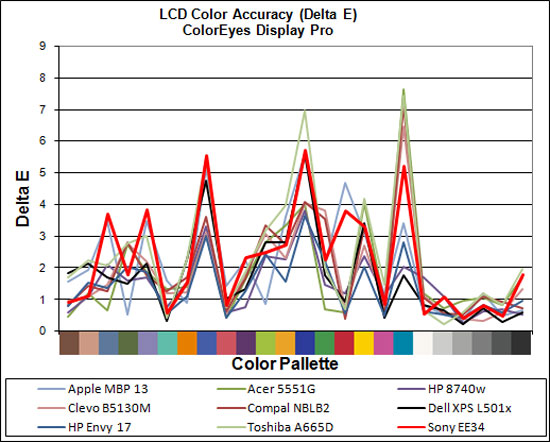
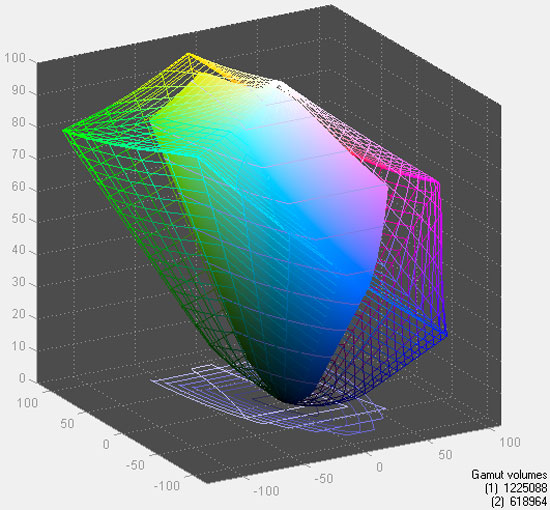
Part of the major problem with these 14" and 15" 1366x768 screens is that they just seem idiotically low-resolution. I was testing the EE34 next to the HP dm1z, and while they produce fairly similar (read: bad) numbers, the dm1z was much more pleasing to look at simply due to the smaller screen producing a finer picture. More and more 1366x768 seems just too small for a screen this size, and what becomes ever more frustrating is that while desktop screen resolutions really have improved somewhat (compare how small 1080p screens get against how small the 1920x1200 screens did), notebook screen resolutions and accompanying quality seem to get worse year over year. Did we really regress so far back that we're going to accept 768 pixels of vertical space again?
But that's not entirely fair to the EE34. Given that with a coupon on NewEgg this notebook can be had for under $600 the complaint becomes more of a general one than specific to the model. Viewing angles aren't completely terrible on the EE34 either, though you'll still spend some time futzing with trying to find the sweet spot (an issue a finer resolution seems to actually improve a bit).















52 Comments
View All Comments
silverblue - Tuesday, February 22, 2011 - link
I really doubt that AMD will release a faster IGP than the 4250 on this type of platform, or even one with more shaders, simply because it detracts from the Fusion initiative. Had they not gone the Fusion route, we probably would be seeing IGPs on the same level as, say, the 3850, by now (one can hope, though Llano should easily meet that).At the very least, it'd have been nice to see a 40nm version of the 4250 and not the 55nm versions we've been seeing for a couple of years, especially since Intel is producing their HD Graphics on a lower node.
nitrousoxide - Tuesday, February 22, 2011 - link
Llano IGP has 320 shaders, and should run at really high frequency. So it's reasonable to expect Mobility 5650 (or GT425M) level performance.mino - Tuesday, February 22, 2011 - link
320 ? Umm. More like 400(+) ...duploxxx - Wednesday, February 23, 2011 - link
ain't that funny arguing about shader count while you actually don't know for sure??? :)Liano will have 160-240-320-400 shaders in notebook depending on model, now you know.
And now it doesn't run really high frequency but indeed the highend will be around Mob 5650 perf and will run circles around anything integrated Intel can offer.
StevoLincolnite - Tuesday, February 22, 2011 - link
That might be true for lower resolutions... Just remember it still has to use system memory which is slower and of higher latency when compared to a discreet cards own memory subsystem (Plus system RAM's bandwidth is shared between all components.)Only so large and complex you can make an IGP before it is essentially pointless, on the bright side compute tasks should be decent.
silverblue - Wednesday, February 23, 2011 - link
It'll handle higher loads than Brazos, though Brazos wasn't really positioned as a gaming option.A triple channel memory interface would be immensely helpful but unfortunately incredibly unlikely to happen. The real value of Llano should be proven by throwing faster RAM at it; those RAM tests which yielded very little improvement should no longer apply.
I can't see Llano achieving 5650 performance in bandwidth-limited situations, however one might argue that anti-aliasing and anisotropic filtering aren't options suited to such platforms so if you leave those out, it should perform quite well.
nitrousoxide - Wednesday, February 23, 2011 - link
1366x768 gaming isn't that bandwidth limited. My laptop runs at 1600x900 with 128bit D3 running at 800MHz. So that's only 25.6GB/s available bandwidth but still managed to run Black Ops/Need for Speed Shift at highest settings and rarely dropped below 30fps. While Llano won't be that fast to handle HD gaming, at 1366x768 (which is the standard resolution for most 14 inch laptops) it should really provide decent gaming experience.drew_afx - Tuesday, February 22, 2011 - link
Thanks for the thorough reviews on this siteit's really informative and accurate
but since a lot of people like myself visit here to
decide on which tech product to choose from,
is it possible to include a comparison chart of carrying weight?
I can see the specs on the first page, but
those i5's and i7 laptops w/ more than double the
charge capacity of sony's battery should be packing at least
a solid pound more. Efficiency wise, it would be better to compare
laptops by weight too, since power vs weight is always good comparison
in cars(efficiency of engine). As the review noted, this range of laptops is
suitable for college students who need multitasking, but don't need
gaming or video encoding power w/ more weight.
Another good measure of laptop comparison can be the
practical part of design. Does the vents on the bottom get blocked
when put on lap?(the pictures w/temps were very helpful) Is it single or dual heatsink/fan?
Is it easy to disassemble and clean vents later? Can it be
held with one hand comfortably, both when opened and closed without flexing?
any sign of lcd distortion when pressed on the back cover? hinge quality?
keyboard & mouse clicking noise level? I think one of the reasons for
apple's success in educational notebooks is due to meeting these practical design
criteria.
Malih - Wednesday, February 23, 2011 - link
interesting, it's good to include these kindof daily usage annoyances test, cause that's what we're facing everyday, it will complete the review as buyer's guideScreammit - Wednesday, February 23, 2011 - link
Positioning of the vents is one of the first things I look at when I make a laptop purchase. I greatly prefer that the main intake or outtake is not on the bottom.